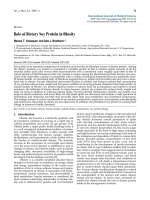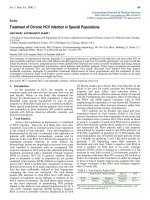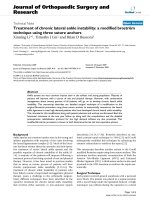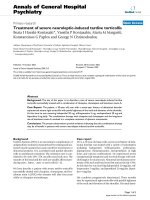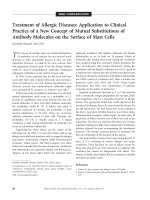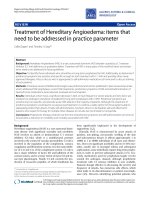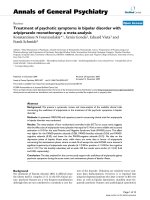Báo cáo y học: "Treatment of Chronic HCV Infection in Special Populations."
Bạn đang xem bản rút gọn của tài liệu. Xem và tải ngay bản đầy đủ của tài liệu tại đây (284.18 KB, 6 trang )
Int. J. Med. Sci. 2006, 3
69
International Journal of Medical Sciences
ISSN 1449-1907 www.medsci.org 2006 3(2):69-74
©2006 Ivyspring International Publisher. All rights reserved
Review
Treatment of Chronic HCV Infection in Special Populations
John Hoefs
1
and Vikramjit S. Aulakh
2
1. Division of Gastroenterology and Hepatology, H.H. Chao Comprehensive Digestive Disease Center UCI Medical Center, Orange,
CA, USA.
2. Mercy Hospital and Medical Center, 2525 S Michigan Ave, Chicago, Illinois, USA.
Corresponding address: John Hoefs, MD, Division of Gastroenterology-hepatology, 101 The City Drive, Building 53, Room 113,
Orange, California 92868. Phone: 714-456-6745 and Fax: 714-456-7753
Received: 2005.12.30; Accepted: 2006.03.18; Published: 2006.04.01
The mainstay of treatment of chronic hepatitis C is pegylated interferon combined with ribavirin and more than 50% of
naïve patients will have viral cure with either 6 months (genotypes 2 and 3) or 12 months (genotypes 1,4, and 6) with the
initial treatment. However, populations have been defined that respond less well to routine treatment including African
Americans, immune suppressed populations, obese patients and cirrhotic patients. These types of patients are enriched
in groups of patients who are non-responders to treatment. This article discusses viral kinetics that may impact
treatment response, strategies to maximize treatment effectiveness in these populations and the treatment of non-
responders in general. Early viral kinetics can be used to define response or non-response and these results can be used
to modify subsequent treatment length and dose.
Key words: HCV, treatment HCV, non-responder, cirrhosis, African American, fatty liver
1. Introduction
In the treatment of HCV, the benefits of peg
interferon alpha and ribavirin have become clear over the
past decade. Where on one hand, this treatment has
proven its effectiveness in ideal population; it has also
identified some special populations by way of poor
response or difficulties faced due to co morbid conditions.
These special populations include patients with cirrhosis,
non responders to prior treatment, HIV positive patients,
patients with African American ethnicity, steatosis, and
post liver transplants.
2. Viral Kinetics.
Active viral replication in hepatocytes is a hallmark
of HCV infection. However, it is likely that viral auto-
regulation [1] as well as immune factors [2] are important
in the control of this infection. Viral auto-regulation is
demonstrated by the lack of unlimited viral replication in
patients with inhibited immunologic systems and by
decrease in the viral RNA level before the emergence of a
significant immune response in acute disease [1].
Immunologic factors are important as recovery from acute
viral hepatitis is associated with an unopposed TH1
response exposed to HCV and is also enhanced following
treatment, associated with a sustained virologic response
(SVR) in Chronic HCV [3]. In general, immune factors
prior to treatment or early in treatment do not predict
sustained viral response (SVR), defined as negative serum
test for HCV RNA 6 months after completion of therapy.
Immune factors may be of major importance once the viral
load has been sufficiently reduced so that hepatocytes
containing the virus are destroyed. The viral kinetic
profile (the decrease in viral RNA level with time) in
response to treatment can be biphasic or triphasic in the
first 4 weeks of treatment. The final phase slope seems to
be the most important in determining SVR perhaps
related to the death of viral infected hepatocytes [4, 5]. A
very early virologic response (VEVR) having a negative
RNA at week 4 correlates with the likelihood of an SVR
[5]. Recent studies have shown that viral reduction in the
blood in the first 2-4 weeks precedes the immunologic
response and may reflect viral reduction below a
threshold that allows effective immune attack of infected
cells [3]. Furthermore, the mutagenic effect of ribavirin on
the NS5A and NS5B regions correlates with an SVR
emphasizing the importance of viral factors [6]. Therefore,
viral reduction may allow immune clearance rather than
immune enhancement causing viral clearance.
HCV patients can be divided into rapid and slow
responders based on viral kinetics (Table 1) [4]. Forty
percent of patients were slow responders in one study and
this correlated with a positive HCV RNA levels in blood
at week 4. A negative 4 week viral RNA level is sensitive
(95%) and relatively specific (83%) marker for viral kinetic
fast responders [4]. Most patients with a fast response
characterized by negative week 4 viral RNA will have an
SVR (90%) regardless of genotype [4, 7]. This implies that
some populations may be treated for short periods of time
i.e. 4 months for genotype 2 and 3 [8] and 6 months for
genotype 1 [9] depending upon their response to
treatment and viral load. Where a negative viral RNA at
week 4 predicts an SVR, lack of an early virologic
response (EVR), which is defined as a minimum of 2 log
decrease in viral load at week 12 of treatment, predicts a
non-response with more than 97% accuracy [5]. Lack of an
EVR is an indication that treatment can either be stopped
or dose increased. Kinetic analysis also suggests the value
of longer treatment if the RNA level becomes negative
after 12 weeks [10].
TABLE 1. Viral Kinetics Predict SVR
Week 4 RNA Week 12 RNA End of
Treatment
SVR
VEVR Negative Negative Negative 90 % *
EVR Positive Negative or <
1/100 baseline
Negative 70 % **
*May shorten treatment course in genotype 2 to 4 months or genotype 1 with
LVL to 6 months with same SVR (8, 9)
Int. J. Med. Sci. 2006, 3
70
**May lengthen treatment by 3 to 6 months if 12 week RNA still positive to
have an increased likelihood of an SVR.
3. Treatment in African Americans
Prevalence of HCV in African Americans is about 3
times greater than Caucasians [11]. The problems of HCV
infected African Americans are that they are more likely
to be infected with genotype 1, more likely to have HCV
complications, have higher rate of cirrhosis, HCC and
death due to HCV[12].
The 4 week log reduction in viral RNA was seen to
be less in African Americans than Caucasians by 50%.
This indicates a larger population of slow responders in
African Americans which may explain a low SVR in this
population compared to other groups [13]. African
American patients showed significantly lower decrease in
HCV RNA over the first 24 hours than Caucasians and
significantly longer delay in initial response and
significant difference in the rate of loss of virus producing
cells [13]. Various studies have ruled out other
explanations including lack of adherence and dose
reduction due to poor tolerance or low baseline
neutrophils, for the poor response. In fact, a larger
percentage of African Americans completed the therapy
in some of these studies compared to other racial groups
despite a greater reduction in neutrophils as anticipated
with the low baseline levels [13]. Despite greater
compliance and similar side effect profile, the SVR was
decreased in African Americans relative to other groups
[11]. Regardless, combination therapy with interferon
alpha and ribavirin remains the treatment of choice for
African Americans with chronic HCV [11].
The lack of suppression by treatment should be
amendable to higher dose treatment or prolonged therapy
once viral suppression is adequate. Though this has not
been studied directly in the African American population,
it has been studied in non responders and relapsers to
prior monotherapy.
4. Immune Suppressed Populations – post liver
transplant or HIV infection
Immune suppressed patients have a higher baseline
RNA level and more rapid progression to cirrhosis [14,
15]. The increase in RNA level supports the importance of
what appears to be a relatively weak, ineffective immune
response since it is inadequate to clear the virus. Since
immunologic mediated inflammation is thought to be the
mechanism of progressive fibrosis, it is surprising that
immune suppression does not ameliorate the disease at
the expense of higher viral levels. The exact relationship of
immune suppression to progression of fibrosis is unclear,
but suggests there may be a differential effect on
lymphocyte sub-populations [16, 17, 18].
In HIV positive patients with HCV, the rate of
fibrosis and rate of progression to cirrhosis or
decompensation (RR=2.92, 95% CI 1.70-5.01) is markedly
increased particularly with reduced CD4 counts [19].
Chronic liver disease has become the most common cause
of death in adequately treated HIV patients [20]. Evidence
for more rapid progression can also be found in HCV
patients with recurrence after liver transplant with > 10 %
having cirrhosis within 5 years [18, 21]. Patients
transplanted for HCV eventually have significantly
reduced survival relative other transplant groups
primarily related to recurrent cirrhosis.
The treatment of these two immunologically
suppressed cohorts are complicated since both are on
multiple drugs with potential for interactions or
hepatotoxicity and which may have independent effects
on bone marrow suppression. Close monitoring is
required along with treatment of cytopenias, dose
reduction, and dose discontinuation (20-30%) in the
management of these patients. Interferon monotherapy
and interferon alpha 2b plus ribavirin have low response
rates (10-30 % and 20-30%, respectively) [15]. Pegylated
interferons plus ribavirin (usually in reduced dose of 800
mg/day) have higher response rates than these latter two
options (30-45%) [15]. The early viral kinetics in these
patients is similar to unsuppressed patients with higher
viral loads baseline. The lack of EVR is equally predictive
of NR (98%) allowing a decision to stop treatment if this
criteria is not met [15].
5. Cirrhotics
Treatment of non-decompensated cirrhotics is
important since they have reduced survival, increased
incidence of HCC and progression to a decompensated
state with ascites and GI bleeding [19]. The goal of therapy
is to prevent progression of liver disease to these poor
clinical outcomes. An SVR has been shown to reduce these
unfavourable outcomes by at least 50 %, but even a
treatment course without a durable virologic response
appears to reduce these complications [13, 20]. These latter
studies have led to clinical protocols of low dose
maintenance treatment in which the goal of therapy is
changed from viral cure to prevention of disease
progression. Clearly, treatment is strongly indicated with
early cirrhosis without decompensation as progression
will occur in the majority of patients. Treatment is more
difficult in the setting of decompensated cirrhosis
although this can produce an SVR in 20-25% of patients
[22].
The SVR for naïve compensated cirrhotic patients is
30-45% compared to 50-55% in non-cirrhotics. Potential
explanations for the reduced SVR could be inherently
poor virologic response with a decrease in the week 4
reduction and intolerance of treatment requiring dose
reduction. Clearly, genotype 2 or 3 and low viral load
predict better results [23]. In a small study, cirrhotics did
not have slow response characteristics which predict non-
response. The major problem appears to be relapse once
medication is stopped. These patients may respond to
longer treatment once the viral levels have become
negative although this has not been studied.
Retreatment of cirrhotics with pegylated interferon
and ribavirin is also associated with a poor SVR (6-12%)
[23]. A low response was found in the retreatment with
pegylated alpha 2a plus ribavirin in cirrhotics (12% SVR)
compared to non-cirrhotics (20% SVR) in lead in phase of
the HALT-C trial [23]. The initial publication from this
trial concluded that ribavirin dose reduction affected the
SVR more than interferon reduction [23] although dose
discontinuation was lumped together with dose
reduction. Subsequent analysis showed that patients with
dose continuation (primarily ribavirin) had virtually no
SVR (1.3%). In the rest, ribavirin reduction to < 60% of
target dose did not affect SVR (17%) as long as pegylated
interferon dose was not reduced.
These patients were further divided into 4 cohorts of
liver disease severity based on the histologic cirrhosis and
platelet count < or > 125,000 cell/mm3 [24]. Those in the
Int. J. Med. Sci. 2006, 3
71
best cohort (non-cirrhotic with platelets > 125,000
cells/mm3) had an SVR of 17% compared to 7-8% in the
cirrhotic groups. In the non-cirrhotic patients, dose
reduction (without discontinuation) had no impact on the
SVR whereas there was a nearly significant effect in
cirrhtoics (12 % with full dose vs 7-8% for dose reduction;
p = .058). Further support for liver disease severity being
the most important factor in the non-response of cirrhotic
patients was provided in an ancillary study of
quantitative liver functions tests that included cholate
shunt and clearance, perfused hepatic mass (PHM) by
quantitative liver spleen scan, and aminopyrine breath
test showed that the most severe quartile of these patients
had an SVR of 2% compared to 17% in the other quartiles
[25]. Severity of liver disease impacts response to
treatment directly rather than primarily through dose
reduction or intolerance.
6. Fatty Liver
Fatty liver predicts a lower SVR regardless of other
factors in both primary treatment (SVR 40-50 % vs 50-55%
without steatosis) and re-treatment of non-responders
with pegylated interferon plus ribavirin (SVR 10-20 %
with vs 20-30 % without) [26]. In pegylated interferon 2b,
weight based dosing have been suggested as an important
factor. Weight based dosing is dependent on
pharmokinetics. It is required for Pegylated alpha 2b and
not for alpha 2a. There is a decrease in SVR in patients
with a fatty liver to a similar degree with both products
using the recommended doses [27]. The weight based
dosing with Peg alpha 2b does not produce better results
in patients with fatty liver.
7. Re-treatment of non-response
Naïve patients initially treated with interferon
monotherapy have a low response rate that is improved
by longer treatment from 24 to 48 weeks [28]. Re-
treatment with peginterferon plus ribavirin will produce
SVR of 28% [23]. Even patients initially treated with
pegylated interferon monotherapy have a 20% SVR to re-
treatment with pegylated combination therapy [29].
Therefore, re-treatment with peginterferon plus ribavirin
should be considered in non-responders or relapsers to
interferon monotherapy.
The effect of longer treatment as a principal can be
seen in the initial studies with interferon monotherapy in
which the SVR increased from 6% with 6 months of
treatment to 12% with 12 months [5, 30]. Additional
evidence comes in the studies of patients treated with PEG
interferon plus ribavirin for 6 months with relapse, who
were then treated for 12 months with a 50% SVR. Those
people with viral suppression during treatment may
benefit from stronger and longer treatment [5].
Table 2 shows the SVR in re-treatment of patients
who were non-responders to combination therapy with
regular interferon and ribavirin. The SVR ranges from 4-
12 %with responses greater with genotypes 2 and 3. The
effect of longer treatment has not been tested. Non-
responders to Peg-interferon plus ribavirin have
exhausted our routine relatively tolerable therapy.
However, dose induction studies attempt to maximize
viral RNA suppression by early higher dose treatment
protocols which are often somewhat longer as well.
Protocol includes ribavirin plus peginterferon alpha 2a at
270 or 360 µg per week and consensus interferon with 27,
18 and 9µg daily [31].
TABLE 2. Retreatment of IFN + RBV failures with PEG-IFN
+ RBV
Investigator Patients Study Drug/Dose SVR
Teuber G, et al. DDW.
2003
240 PEG-IFN α-2b
100µg + RBV 800
mg x 8wk, PEG-
IFN α-2b 50 µg +
RBV 800 mg x 40
wk
6.3%
Jacobson I, et al.
DDW 2003
219 PEG-IFN α-2b 1.0
µg/kg + RBV 1-
1.2g x 48 wk,
PEG-IFN α-2b 1.5
µg/kg + RBV 800
mg x 48wk
6%
10%
Sulkowski M, et al.
DDW 2003
517 PEG-IFN α-2b 1.5
µg/kg + RBV
800mg x 48 wk,
PEG-IFNα-2b
100/150 µg + RBV
800 mg x 48 wk
12%
Lawitz E, et al. DDW
2003
486 PEG-IFN α-2b 1.5
µg + RBV 800 mg
x 48 wk, PEG-IFN
α- 2b 1.0 µg/kg +
RBV 800 mg x
36/48 wk
5-10%
Gross JB et al, AASLD
2003
764 PEG-IFN α 2b
0.5/1.5/3 µg/kg
RBV 12-15 mg/kg
x 48 wk
4-11%
Shiffman ML et al
Gastroenterology
2004
210 PEG-IFN α 2a 180
µg + RBV 1-1.2 g x
48 wk
12%
Re-treatment has not been investigated directly in
large numbers of patients with co-infection, fatty liver or
cirrhosis. However, the non-responder re-treatment trials
are enriched with these patients as are the lead-in phase of
the some of the maintenance studies. Furthermore, some
trials now define non-responder as early as 12 or even 4
weeks modifying treatment with either stronger treatment
or longer treatment to try to produce a better SVR [7, 32].
8. Longer treatment
Kinetic studies suggest potential value for large
treatment in patients who slowly become RNA negative,
particularly in genotype 1 patients [10]. A study by
Sanchez-Tapias et al [7] treated patients with a pegylated
alpha 2a plus ribavirin (1000 or 1200 mg ) for 4 weeks.
Preliminary data in abstract form showed those patients
that have a negative RNA by PCR ( 40% of cohort)
continued treatment for either 6 or 12 months depending
on genotype with SVR of 92%. Those patients who were
RNA positive were randomized to either a total of 48
weeks or 72 weeks followed by RNA levels 6 months after
stopping with SVR of 35 and 50 % respectively (p<.001).
Slower responders benefit from longer treatment.
9. Stronger treatment
Induction studies have treated patients with non-
response and relapse with higher
Doses of Consensus or pegylated interferons for the
first 1-12 weeks followed by continued high dose or return
to more normal treatment regimes. Retreatment under a
variety of protocol conditions have achieved SVR from 25-
40% in patients with expected response rates of 1-12%.
Most of the results from these very interesting studies are
published in abstract form and we are waiting the
publication of the full articles.
A study by Kaiser, et al [31] of induction dosing with
daily Consensus interferon and Ribavirin (11 mg/kg/day)
starting after week 4. Thirty patients in group A received
Int. J. Med. Sci. 2006, 3
72
27 ug SC daily for 4 weeks followed by 18 ug daily for 12
weeks and the second group B of 30 patients received 9 ug
SC daily for 16 weeks. At the end of 16 weeks, all patients
were treated with 9 ug SC daily until the patient had been
HCV RNA negative for 48 weeks. RNA was negative at 24
weeks in 47% and 40%, respectively, and at the end of
treatment in 50% and 43%. The SVR was 27% in group A
and 23% in group B. Adverse events, dose discontinuation
(10 vs 3%) and dose reduction (23 vs 10%) were similar to
conventional therapy. All patients were treated longer
than 48 weeks (if treatment was not stopped) and the
average was 60 weeks.
One study by Leevy, et al [33] treated patients with
peg interferon alpha 2b (1.5 ug/kg weekly) and weight
based ribavirin (1000-1200 mg per day) for 3 months.
Patients without an EVR were then treated with
consensus interferon 15 ug daily for 3 months followed by
15 ug TIW for the remainder of treatment for a total of 15
months of treatment. RNA negativity at 12, 24 and 48
weeks was 23, 31 and 43 %. SVR was 37 % overall and 27
% in AA compared to 41% in non-AA. This study mimics
the situation in clinical practice in which failure during
therapy is followed by the decision to treat with higher
dose or to stop treatment as ineffective. Despite fatigue
and tiredness in nearly all patients and a decrease in ANC
to < 750 cells/mm3 in 22 %, no patients stopped
treatment.
A small study (75 patients) by Diago et al [34]
assessed induction dose with pegylated interferon alpha
2a in three cohorts of genotype 1 patients who were non-
responders to regular interferon alpha 2b plus ribavirin.
All patients were treated for 44 weeks with 180µg
pegylated alpha 2a and ribavirin after an initial 4 week
induction dose of 180, 270 360µg per week ( total
treatment of 48 weeks). The SVR was 18%, 30% and 38%
in the respective groups. Gitlin et al [35] reported results
in patients with non-response to pegylated alpha 2b plus
ribavirin. The SVR in response to retreatment with
pegylated alpha 2a plus ribavirin was 32% overall with
27% in cirrhotics and 14% in African Americans.
The results of RENEW trial of induction dosing using
pegylated alpha 2b plus ribavirin in 650 interferon alpha
2b plus ribavirin non-responders were less encouraging.
The SVR to 0.5µg/kg, 1.5µg/kg and 3µg/kg was 4%, 7%
and 11% respectively [36]. However, the TARGET trial of
3.0µg/kg of pegylated alpha 2b plus ribavirin showed
SVR of 14% [37].
In conclusion, higher dose and induction dosing
seems to produce acceptable salvage SVR in patients who
are non-responders to prior combination therapy.
10. Recommendations
In naïve patients in special populations, the
treatment can be started off with regular dose of
pegylated interferon and weight based dosing for
ribavirin. However, since these populations in general
have a lower response rate, it seems reasonable to modify
dosage or length of treatment based on 4
th
and 12
th
week
viral RNA level. Patients with genotype 2 or 3 and
genotype 1 with low viral load who became negative for
viral RNA at week 4 , may have a shorter length of
treatment of 4 months and 6 months respectively without
sacrificing the SVR.
In patients who are RNA positive at week 4 and do
not meet the EVR criteria at week 12, then the treatment
can be stopped or considered for dose escalation with
pegylated interferon or daily dosing with infergen. If Viral
RNA is positive at week 4 but meets EVR at week 12,
medication should be continued. If HCV RNA by PCR is
not negative by month 6, then treatment can be stopped or
considered for dose escalation. But if it does become
negative by month 6, it seems reasonable in this group of
difficult to treat patients to treat for 72 months total as
long as RNA remains negative. The role of maintenance
treatment in these special groups of non-responders is not
clear, but should be considered in those with moderate
fibrosis or cirrhosis.
Conflict of interest
The first author declared that the only potential
conflict of interest is prior relationship to Roche as a
speaker. None declared for the second author.
References
1. Sallie R. Replicative Homeostasis: A fundamental mechanism
mediating selective viral replication and escape mutation. Virol J.
2005; 2: 10-23
2. Chisari FV. Unscrambling hepatitis C virus-host interactions. Nature
2005; 436(7053): 930-2
3. Bowen DG, Walker CM. Adaptive immune responses in acute and
chronic Hepatitis C virus infection. Nature 2005; 436(7053): 946-52.
4. Tang KH, Herrmann E, et al. Relationship between early HCV
kinetics and T-cell reactivity in Chronic Hepatitis C genotype 1
during peginterferon and ribavirin therapy. J Heptol. 2005; 43(5):
776-82
5. Ferenci P. Predicting the therapeutic response in patients with
chronic hepatitis C: the role of viral kinetic studies. Journal of
Antimicrobial chemotherapy, 2004; 53:15-18
6. Asahina Y, Izumi N et al. Mutagenic effects of ribavirin and response
to interferon/ribavirin combination therapy in chronic hepatitis C. J
Hepatol. 2005; 43(4): 623-9.
7. Sanchez-Tapias JM et al. Sustained virological response after
prolonged treatment with peginterferon alfa-2a (40KD) and ribavirin
in treatment- naïve patients with chronic hepatitis C and detectable
HCV RNA after week 4 of therapy: TERAVIC-4 study. In: Poster
abstracts presented at 39th Annual Meeting of the European
Association for the Study of the Liver; April 14-18, 2004; Berlin,
Germany
8. von Wagner M, Huber M, Berg T et al. Peginterferon alpha 2a
(40KD) and ribavirin for 16 or 24 weeks in patients with genotype 2
or 3 chronic hepatitis C. Gastroenterology. 2005; 129(2): 522-7
9. Zeuzem S, Buti M, Ferenci P, el al. Efficacy of 24 weeks treatment
with peginterferon alfa-2b plus ribavirin in patients with chronic
hepatitis C infected with genotype 1 and low pretreatment viremia.
J Hepatol. 2006;44(1):97-103.
10. Drusano GL, Preston SL. A 48-week duration of therapy with
pegylated interferon alpha 2b plus ribavirin may be too short to
maximize long-term response among patients infected with
genotype-1 hepatitis C virus. J Infect Dis. 2004;189(6):964-70.
11. Bacon BR, McHutchison JG. Treatment issues with chronic hepatitis
C: special populations and pharmacy strategies. Am J Manag Care.
2005;11:S296-306
12. Howell C, Jeffers L, Hoofnagle JH. Hepatitis C in African Americans:
summary of a workshop. Gastroenterology. 2000;119:1385-1396.
13. Jeffers LJ, Cassidy W, Howell CD, et al. Peginterferon alfa-2a (40 kd)
and ribavirin for black American patients with chronic HCV
genotype 1. Hepatology. 2004;39:1702-1708.
14. Heathcote EJ, Pockros PJ, Fried MW, et al. The pharmacokinetics of
pegylated-40K interferon alfa-2a (PEG-IFN) in chronic hepatitis C
(CHC) patients with cirrhosis. Gastroenterology. 1999;116(4):737.
15. Torriani FJ, Rodriguez-Torres M, Rockstroh JK. Peginterferon alfa-2a
plus ribavirin for chronic hepatitis C virus infection in HIV-infected
patients. N Engl J Med. 2004;351(5):438-450.
16. Graham CS, Baden LR, Yu E. Influence of human immunodeficiency
virus infection on the course of hepatitis C virus infection: a meta-
analysis. Clin Infect Dis. 2001;33:562-569.
Int. J. Med. Sci. 2006, 3
73
17. Lindsay KL, Trepo C, Heintges T, et al. A randomized, double-blind
trial comparing pegylated interferon alfa-2b to interferon alfa-2b as
initial treatment for chronic hepatitis C. Hepatology. 2001;34:395-403.
18. Terrault NA. Treatment of recurrent hepatitis C in liver transplant
recipients. Clinical Gastroenterol Hepatol. 2005; 10:S125-31
19. Lee W, Dieterich D. Challenges in the management of HIV and
hepatitis C virus infection. Drugs. 2004;64(7):693-700
20. Bica I, McGovern B, Dhar R, et al. Increasing mortality due to end-
stage liver disease in patients with Human Immunodeficiency Virus
infection. Clin Infect Dis. 2001;32:492-497.
21. Oldakowska-Jedynak U, Paczek L. The course of hepatitis C infection
after liver transplantation. Pol Merkuriusz Lek. 2005; 19(110): 220-4.
22. Everson GT, Trotter J, Forman L, Kugelmas M, Halprin A, Fey B, Ray
C. Treatment of advanced hepatitis C with a low accelerating dosage
regimen of antiviral therapy. Hepatology. 2005;42(2):255-62
23. Shiffman ML, Di Bisceglie AM, Lindsay KL. Peginterferon slfa-2a
ribavirin in patients with chronic hepatitis C who have failed prior
treatment. Gastroenterology. 2004;126:1015-1023.
24. Everson E, Schiffman M, Hoefs J, et al. Quantitative liver function
tests predict sustained virologic response to retreatment with
peginterferon alfa-2a plus ribavirin: results of the lead-in phase of
the halt-C trial. Hepatology 2004; 40:313A.
25. Everson E, Hoefs J, Malet P. Impaired virologic response in patients
with advanced liver disease due to chronic hepatitis C is
independently linked to severity of disease: results from the Halt C
Trial. Hepatology 2004; 40: 180A.
26. Harrison SA, Brunt EM, Oliver DA, et al. The presence of severe
steatosis or steatohepatitis impairs response to antiviral therapy in
patients with chronic hepatitis C. Hepatology. 2003;38(1):A626.
27. Bruno R, Sacchi P et al. Viral dynamics and pharmacokinetics of
peginterferonalpha-2a and peginterferon alpha-2b in naïve patients
with chronic hepatitis C: a randomized, controlled study. Antivir
Ther. 2004; 9(4): 491-7
28. Enriquez J, Gallego A, Torras X, Perez-Olmeda T, Diago M, Soriano
V, Lujan MS, Garcia-Samaniego J. Retreatment for 24 vs 48 weeks
with interferon-alpha2b plus ribavirin of chronic hepatitis C patients
who relapsed or did not respond to interferon alone. J Viral Hepat.
2000 ;7(6):403-8.
29. Sethi A, Shiffman ML. Approach to the management of patients with
chronic hepatitis C who failed to achieve sustained virologic
response. MD consults core collection. Clinics in Liver Disease 2005;
9: 453
30. Horvath G, Stotz G et al. The effect of long term and high dose
interferon treatment in chronic hepatitis C. Pathol Oncol Res.
1996;291: 59-62
31. Kaiser S et al. Successful retreatment of chronic hepatitis C patients
with a nonresponse to standard interferon/ribavirin using daily
consensus interferon and ribavirin. In: 55th AASLD Abstract 173
(poster); October 29-November 2, 2004; Boston, MA.
32. Dimarco V, Vaccaro A, Ferraro D et al. High dose prolonged
combination therapy in non-responders to interferon monotherapy
for chronic hepatitis C. Alimentary pharmacology and therapeutics
2001,15: 953-958
33. Leevy CB, Chalmers CP et al. Comparison of African American and
Non African American patients SVR for PEG-IFN alpha 2 + weight
based ribavirin non-responders retreated with IFN alpha + weight
based ribavirin. In: AASLD Abstract 172; Oct 29- Nov 2, 2004;
Boston, Massachusetts.
34. Diago et al. High dose peginterferon alfa 2a (40KD) and ribavirin in
patients infected with hepatitis C virus genotype 1 who failed to
respond to interferon alfa and ribavirin. Abstract Hepatology, 2003,
38: 740-741
35. Gitlin N, Muther KD. Sustained viral response with peginterferon
alpha 2a and ribavirin in patients with chronic hepatitis C who were
non-responders to peginterferon alpha 2b and ribavirin. In: AASLD
(Abstract 413); Oct 29- Nov 2 2004; Boston, MA.
36. Gross JB et al. Renew Trial- High dose re-treatment with
peginterferon alpha 2b plus ribavirin for non responders in chronic
HCV patients. In: AASLD 2003 (Abstract 321); Oct 24-28 2003; Boston
, MA.
37. Malet P, et al. The Target Trial- Final result using 3.0µg/kg
pegylated Interferon alpha 2b plus ribavirin for chronic hepatitis C
patients who were non-responders and relapsers to previous
therapy. In: AASLD presentation; Nov 15 2005; CA, US.
Author biography
John Hoefs has been involved in research at the
University of California Irvine where he has been Director
of the Liver Disease Program for more than 25 years. He
reported the mathematic model for colloid osmotic
pressure and hydrostatic balance into the peritoneal cavity
and the use of the serum to ascites albumin gradient
(SAAG) in the differential diagnosis of ascites. Much of
his research and clinical effort has been in the developing
of a non-invasive evaluation of liver function using the
quantitative liver-spleen scan and the treatment of chronic
hepatitis C. He was involved in many of the early studies
(since 1989) of interferon mono-therapy, consensus
interferon trials, Rebetron combination therapy and
treatment studies with pegylated alpha-2-b combination
treatment. Most recently, the University of California
Irvine has been one of the sites of the HALT-C trial. Thus,
he has a large clinical experience with chronic hepatitis C.
Vikramjit S. Aulakh: Dr Aulakh is a resident at Mercy
Hospital and Medical Center in Chicago, Illinois. He
served in a research preceptorship at the University of
California Irvine.
